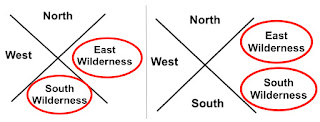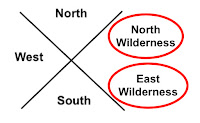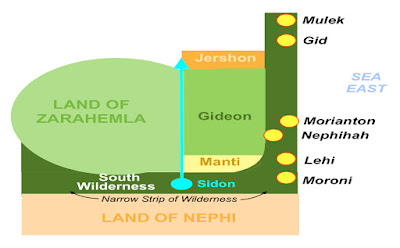When trying to understand the writing of the ancients, such as Mormon, Nephi, et al., modern man simply cannot seem to come to grips with their point of view, but insists on putting his own thinking into the matter that is so out of alignment with that of the ancients.
Left: The ancient Hebrews directional system contained eight compass points; Right: Our compass system today contains 32 directions. It is not just that they did not have these divisions, they did not think in terms of such minute directions
Thus, when Mormon describes an East Sea or an East Wilderness, we need to understand that it was in the east and not somewhere else. The same is true with the South Wilderness or a West Wilderness. Consequently, we need to place an East Wilderness and a South Wilderness within their proper north, east, south, and west orientation to the Point of View of the writer, which is the Land of Zarahemla.
Left: Correct usage of east and west wildernesses; Right: Incorrect. When someone places both the East and South Wilderness in the East, it is simply not something the Hebrews or Nephites would have ever done and never did do
The problem is, and always is, that the Hebrews/Jews/Nephites did not think the way we think today. First of all, they would never put a north or south anything in the east—the East was a pure direction. It was their entire being, their entire religion base, the way they drew maps, and thought of their universe. Nor would they have doubled up on two directions in a single direction, like the Mesoamericanists’ seas above or the Venice Priddis’ map.
It simply would never happen—it simply is not within the Hebrew/Jewish/Nephite mindset to think that way. East of Zarahemla would be an East Wilderness, not a South Wilderness. In fact, everything to the East of Zarahemla (or even Bountiful and Nephi) would be East in Hebrew directional thinking—never anything else.
After the Lamanites were driven out of the “east wilderness” Moroni caused that the Nephites possess the land and build cities in the “east wilderness”
Isn’t it interesting that Mormon does not mention anything about a “south wilderness” where these cities were built and from which Moroni drove out the Lamanites, yet that is exactly where some claim the South Wilderness was located.
Also, in the Nephites building a city where the Lamanites had been driven out named “Moroni,” which was near the Land of Nephi, how would the Nephites drive the Lamanites out of the East Wilderness that was unattached to the Land of Nephi, with a “south wilderness” in between. Or build cities along the eastern seacoast just north of the narrow strip of land and the Land of Nephi without a mention of a south wilderness there?
Of course, that is not the main point here. The point is and needs to be the basis of anything regarding directions, is the fact, and irrefutable fact, and not one of someone’s interpretation, the Hebrews and Jews, therefore the Nephites who were from that stock, and spoke and wrote Hebrew, would simply not have placed names to wildernesses as some have done. It would have violated their entire thinking process and their entire vision of the world around them.
Consider someone living in Los Angeles claiming the Pacific Ocean was to their east. They woud simply laugh at you. Or someone in Salt Lake City claiming the Great Salt Lake was to the southwest, or that St. George was located in northern Utah, or Toole was located in southeast Utah. Claiming that any of these were correct, would simply be rejected by any Utahn, and most anyone else with any knowledge of the state. It would be like someone returning from a visit to Jerusalem and saying that the Muslim Quarter was in the southwestern quadrant of the city, the Dome of the Rock on the Temple Mount was beyond the New Gate into the Christian Quarter, or that the Cathedral of St. James was in the Jewish Quarter. Unless you had been there, lived there, or studied the city, you might accept those comments—but they would be completely incorrect, as any resident of Jerusalem would readily know.
What if someone wrote a book about Jerusalem and listed Zion’s Gate as being in the Armenian Quarter, Tanner’s Gate being in the Christian Quarter, Lion’s Gate being in the Muslim Quarter, and the Dung Gate being in the Jewish Quarter? Or stated that Jesus went to the Pool of Siloam in the Upper City, walked along the wall of the Lower City? Would you know if those geographical statements were correct or incorrect? Actually six of those eight statements are geographically wrong. But how would you know that without study? Yet, people pick up a book written by someone, read their theory about the Great Lakes, the Heartland, or eastern U.S. and accept what they say without knowing how inaccurate they are. Some get so interested, they parrot the comments and the beliefs without ever coming to a knowledge of their inaccuracy.
When it comes to the directions in the scriptural record, it is imperative to understand that in the ancient world, names did not carry much weight in meaning to a lone traveler or to an individual trying to find his way around an unknown city. However, directional names were readily apparent. You can call something the “water gate,” but calling it the “southeast gate,” means far more. Just like the “Road to the East Sea,” meant far more to someone than “Hezekiah’s Road,” and would be far more likely to know where it was located. The same is true of calling it Nehemiah’s Wall or the “north wall.”
The point is, ancient directions are not something to playh around with and make all sorts of absurd claims that might make sense to a modern thinker, but would have been simply unusable and, therefore, not accurate, to the ancient world and ancient-thinking people. Directions were critical to survival, or at least in understanding the world around them. The ancients built elaborate structures and systems in order to simply know what any modern child can learn by looking at a calendar or acquiring a rudimentary understanding of planting cycles.
Therefore, when Mormon used directions, he was not only thinking in terms of the way things were called and understood anciently, but he was also providing us with a better understanding of the directions of the Land of Promise and the location of lands and areas within it.
There is simply no question that before the Hebrews and many other ancient peoples came into a more modern and mobile world, their vision of their land and the world around them was very limited and direction-driven. Everything about their language, their words, the scriptural meaning, the work of uncounted rabbis continually studying the ancient language and to understand it and its deeper meanings, all support the understanding of singular directional placement and naming. It simply cannot be violated because of modern ideas and modern interpretation of ancient writings.
For this or that theorist to make such ridiculous claims about directions that runs contrary to that understanding and the Hebrew mindset about directions and his ancient understanding of his world is so without merit, that it is not only confusing to modern man, but downright fallacious and unworthily misleading.








